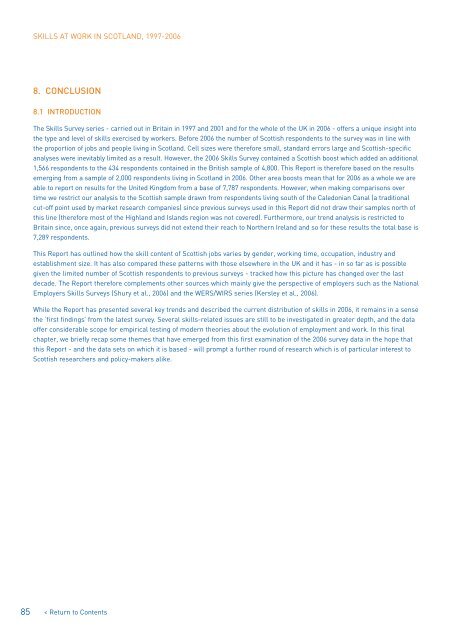Skills at Work in Scotland 1997 to 2006 - Scottish Government
Skills at Work in Scotland 1997 to 2006 - Scottish Government
Skills at Work in Scotland 1997 to 2006 - Scottish Government
Create successful ePaper yourself
Turn your PDF publications into a flip-book with our unique Google optimized e-Paper software.
SKILLS AT WORK IN SCOTLAND, <strong>1997</strong>-<strong>2006</strong><br />
8. CONCLUSION<br />
8.1 INTRODUCTION<br />
The <strong>Skills</strong> Survey series - carried out <strong>in</strong> Brita<strong>in</strong> <strong>in</strong> <strong>1997</strong> and 2001 and for the whole of the UK <strong>in</strong> <strong>2006</strong> - offers a unique <strong>in</strong>sight <strong>in</strong><strong>to</strong><br />
the type and level of skills exercised by workers. Before <strong>2006</strong> the number of <strong>Scottish</strong> respondents <strong>to</strong> the survey was <strong>in</strong> l<strong>in</strong>e with<br />
the proportion of jobs and people liv<strong>in</strong>g <strong>in</strong> <strong>Scotland</strong>. Cell sizes were therefore small, standard errors large and <strong>Scottish</strong>-specific<br />
analyses were <strong>in</strong>evitably limited as a result. However, the <strong>2006</strong> <strong>Skills</strong> Survey conta<strong>in</strong>ed a <strong>Scottish</strong> boost which added an additional<br />
1,566 respondents <strong>to</strong> the 434 respondents conta<strong>in</strong>ed <strong>in</strong> the British sample of 4,800. This Report is therefore based on the results<br />
emerg<strong>in</strong>g from a sample of 2,000 respondents liv<strong>in</strong>g <strong>in</strong> <strong>Scotland</strong> <strong>in</strong> <strong>2006</strong>. Other area boosts mean th<strong>at</strong> for <strong>2006</strong> as a whole we are<br />
able <strong>to</strong> report on results for the United K<strong>in</strong>gdom from a base of 7,787 respondents. However, when mak<strong>in</strong>g comparisons over<br />
time we restrict our analysis <strong>to</strong> the <strong>Scottish</strong> sample drawn from respondents liv<strong>in</strong>g south of the Caledonian Canal (a traditional<br />
cut-off po<strong>in</strong>t used by market research companies) s<strong>in</strong>ce previous surveys used <strong>in</strong> this Report did not draw their samples north of<br />
this l<strong>in</strong>e (therefore most of the Highland and Islands region was not covered). Furthermore, our trend analysis is restricted <strong>to</strong><br />
Brita<strong>in</strong> s<strong>in</strong>ce, once aga<strong>in</strong>, previous surveys did not extend their reach <strong>to</strong> Northern Ireland and so for these results the <strong>to</strong>tal base is<br />
7,289 respondents.<br />
This Report has outl<strong>in</strong>ed how the skill content of <strong>Scottish</strong> jobs varies by gender, work<strong>in</strong>g time, occup<strong>at</strong>ion, <strong>in</strong>dustry and<br />
establishment size. It has also compared these p<strong>at</strong>terns with those elsewhere <strong>in</strong> the UK and it has - <strong>in</strong> so far as is possible<br />
given the limited number of <strong>Scottish</strong> respondents <strong>to</strong> previous surveys - tracked how this picture has changed over the last<br />
decade. The Report therefore complements other sources which ma<strong>in</strong>ly give the perspective of employers such as the N<strong>at</strong>ional<br />
Employers <strong>Skills</strong> Surveys (Shury et al., <strong>2006</strong>) and the WERS/WIRS series (Kersley et al., <strong>2006</strong>).<br />
While the Report has presented several key trends and described the current distribution of skills <strong>in</strong> <strong>2006</strong>, it rema<strong>in</strong>s <strong>in</strong> a sense<br />
the ‘first f<strong>in</strong>d<strong>in</strong>gs’ from the l<strong>at</strong>est survey. Several skills-rel<strong>at</strong>ed issues are still <strong>to</strong> be <strong>in</strong>vestig<strong>at</strong>ed <strong>in</strong> gre<strong>at</strong>er depth, and the d<strong>at</strong>a<br />
offer considerable scope for empirical test<strong>in</strong>g of modern theories about the evolution of employment and work. In this f<strong>in</strong>al<br />
chapter, we briefly recap some themes th<strong>at</strong> have emerged from this first exam<strong>in</strong><strong>at</strong>ion of the <strong>2006</strong> survey d<strong>at</strong>a <strong>in</strong> the hope th<strong>at</strong><br />
this Report - and the d<strong>at</strong>a sets on which it is based - will prompt a further round of research which is of particular <strong>in</strong>terest <strong>to</strong><br />
<strong>Scottish</strong> researchers and policy-makers alike.<br />
85 < Return <strong>to</strong> Contents

















